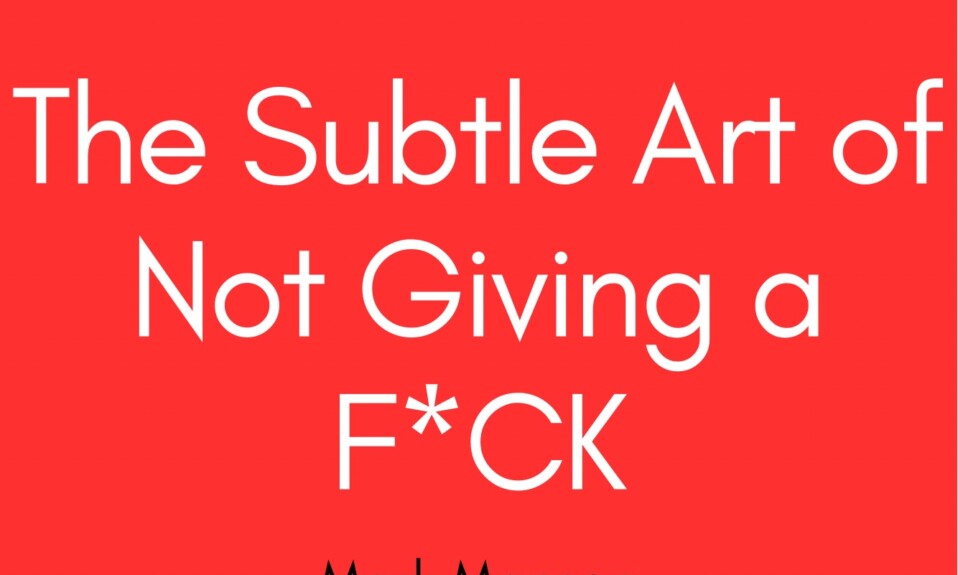
Overview
The book the subtle art of not giving a f summary by Charles Manson is a self-help guide that focuses on acceptance and the pursuit of happiness. Manson’s tone is crude and over-the-top, with the epitaph written on Charles Bukowski’s tombstone as a rallying cry. He advises that we should care about things that truly matter to us and that self-assessment of what’s important versus what should be important is crucial. Manson criticizes modern societal trends, such as the pursuit of high self-esteem and the trend brought about by social media, which emphasizes exceptionalism as the standard for feeling worthy.
Manson uses anecdotes to introduce topics, such as the story of Hiroo Onoda and the Buddha’s response to suffering. He believes that acceptance is the key to a fulfilling life, and that we must fully accept certain unavoidable truths, such as mortality and suffering. He argues that denying or avoiding these truths leads us away from happiness and that our response to pain, suffering, and death is within our control.
Manson’s abrasive tone is intended to test the reader’s resolve and to illustrate that an honest approach to self-help books is more useful than halfheartedly attempting to lull the reader. He sees his purpose as guiding readers towards confronting darker elements and showing a path towards a more fulfilling life.
Chapter One Analysis
Manson’s opening narrative is a brief overview of the life and rise to prominence of writer Charles Bukowski. Manson understands that incorporating Bukowski—who he describes as “a womanizer, a chronic gambler, a lout, a cheapskate, a deadbeat, and on his worst days a poet” (1)—is a contradictory strategy. Manson admits that with a work of this sort, Bukowski is the last place you’d seek for a lesson or a positive message. However, part of Manson’s approach in the book is to encourage people to think in unconventional ways, therefore referencing Bukowski’s rise to prominence is appropriate. Manson notices the epitaph on Bukowski’s tombstone, which reads “Don’t try,” and spends the rest of the chapter deciphering what it could mean.
YOU CAN ALSO READ: Devil in a Blue Dress Summary
The epitaph could be interpreted as a statement of nihilism. However, as Manson puts it, a more realistic judgment would be “don’t try too hard” or “only try at what you care about.” Bukowski clearly cared about his own writing, and he worked hard to become a good writer. He achieved his success, however, through toil, grit, and hard work—and, more importantly, through his ability to see and accept himself for who he was: “His success stemmed not from some determination to be a winner, but from the fact that he knew he was a loser, accepted it, and then wrote honestly about it” (2). Bukowski’s method paid brilliantly, and his work is, if anything, extremely honest. Manson sees this as an admirable attribute, but in order to be real, we must first understand ourselves as individuals.
The first chapter is notable for its excessive use of the F-word. Without a doubt, the book’s title raises expectations, and the usage of the F-word in the first chapter is inevitable. However, the term’s persistent and excessive use contradicts even these expectations. The result is that Manson is virtually testing the reader’s resolve here, demonstrating that his objective is not to use purple writing to ease us into the points he makes; rather, Manson wants us to feel uncomfortable, and the profanity nudges us beyond of our comfort zone.
Chapter 2 Analysis.
Just as the first chapter takes an unconventional approach to establishing its ideas, the second chapter follows suit. The chapter’s title, “Happiness is a Problem,” immediately stands out as a complete contradiction to what Western culture touts as the ideal—namely, that the search and accomplishment of happiness is the goal of life. In the United States, the phrase “pursuit of happiness” is included into the Declaration of Independence. In any case, the chapter title is shocking, and that’s the idea again. Manson wants to keep us on edge and push us out of our comfort zone. The title has the effect of provoking us into a defensive stance. Because it challenges what is often accepted as conventional thought, it prepares us to interact with Manson—even if simply to understand where he went wrong.
YOU CAN ALSO READ: The Housekeeper and the Professor by Yōko Ogawa
Manson examines here the idea that happiness isn’t always a problem. It exists, just like pain does. The issue, according to Manson, is in how we approach pursuing happiness: “There is a premise that underpins many of our assumptions and ideas. The notion is that happiness is algorithmic, that it can be worked for, acquired, and accomplished just like getting into law school” (25). As a general remark, this is likely correct. There is a propensity to view happiness as the product of some formula involving a high-risk payoff—perhaps the reward for a successful venture. Manson has an alternative definition of happiness, one that is not based on external criteria and does not have a specific ultimate aim.
Much of Manson’s worldview is around accepting the fundamental facts of life. To put it another way, denying the existence of misery in the world serves no purpose. Suffering is an unavoidable part of existence. It’s unavoidable—and the sooner you accept it, the easier it will be to move through your pain. Furthermore, Manson highlights other mundane elements, such as “problems,” which he also sees as facts of existence: “Problems are a constant in life” (30), and even when we solve one problem, others frequently arise in relation to the original problem. Every time we solve a problem, we create another. Manson believes that happiness is primarily the consequence of problem solving. As a result, if we try to ignore or minimize the number of difficulties in our lives, we reduce our chances of experiencing the enjoyment that comes with resolving them.
Chapter 3 Analysis
This chapter is possibly the most openly critical of the entire book. Manson criticizes the idea that promotes high self-esteem as the solution to all of a person’s problems. As long as a person feels good about himself, they will eventually find happiness. Manson wholeheartedly disagrees with this idea. He also challenges the idea that we are all unique and exceptional, which he sees as part of a larger philosophical approach. To Manson, none of us is truly unique. Our difficulties are, at their foundation, issues that someone else has faced at some point. Manson’s tone in this chapter is strongly evocative of Ecclesiastes from the Old Testament. Essentially, everything has already been done, there is no truly original experience, and we are all insignificant. Manson sees the self-esteem viewpoint as a flaw since it promotes the opposite.
At the center of Manson’s worldview is the concept of acceptance. Striving to accept one’s place in the universe on a big scale will not result in nihilism. It can even have the opposite effect: persons who accept their insignificance are more likely to experience release and independence than those who insist on viewing themselves as unique. Manson portrays Jimmy as an example of self-esteem gone too far. Jimmy is a superficial individual who believes in himself to the point where he stands for nothing else. His main values are self-esteem and confidence. He measures this outwardly, materialistically, and thus almost completely ignores the substance of what constitutes a good existence. Jimmy and others like him are motivated by the desire to feed and elevate their egos. Manson sees this as the natural conclusion of culture’s desire for self-esteem.
Manson makes an intriguing point regarding the fault in the self-esteem movement:
YOU CAN ALSO READ: The Girl Who Loved Tom Gordon by Stephen King
The issue with the self-esteem movement was that it judged self-esteem based on how positive people felt about themselves. However, how people feel about their negative qualities is a true and accurate assessment of their self-worth (44).
According to Manson, the self-esteem movement concentrates people on what they’re excellent at—or on attributes they see as positive—which is a problem. Instead, shifting the attention to the negative creates a chance to address those weaknesses. Rather than avoiding the unpleasant, Manson recommends accepting it, which allows one to better understand oneself and stimulates growth towards becoming much more resilient.
Chapter 4 Analysis
The incredible story of Hiroo Onoda opens this chapter on the importance of suffering. Once again, the chapter title, because it is unconventional, nearly begs us to participate. Typically, we regard suffering as something to avoid at all costs. Sure, it happens, but that doesn’t imply we should value it. Again, Manson believes this is a flawed perspective. He utilizes the Onoda incident to demonstrate that not all pain has the same cause, and this distinction teaches an important lesson. He remarks on Onoda and the young guy named Suzuki, who eventually persuaded Onoda that the war had ended some 30 years later: “To both individuals, their suffering meant something; it served some higher purpose. And because it meant something, they were able to bear it” (68). Manson is pointing out that not all pain is equal; in some circumstances, if we believe in the reason for our suffering, we can bear it. Onoda’s 30-year survival in the Philippine bush demonstrates his belief in his cause—performing his duty to the Japanese Imperial Army. Manson utilizes the Onoda story to demonstrate the extent to which humans may endure if they believe their cause is justified.
Onoda’s pain was not totally self-inflicted, as Manson explains later in the chapter that suffering is frequently the result of something bad occurring to us. In other terms, we are “victimized” by something, such as being afflicted with an illness and having no control over its progression. We can’t simply change how we think about cancer to have it go away. However, while Manson acknowledges this, he shifts his focus to those who suffer in more superficial ways, such as when people make themselves victims. People who suffer as a result of having established erroneous happiness measures are typically individuals whose values, like Jimmy’s in the previous chapter, are lacking or inauthentic.
Manson provides examples of “shitty values” such as “pleasure,” “material success,” “always being right,” and “staying positive” (81-83). Having these principles prepares a person for the types of difficulties that nearly always occur and, according to Manson, are particularly difficult to fix. Manson contends that pleasure and achievement should result from doing things in a way that adds actual value to one’s life; they should not be the driving force behind our actions. Manson says that we base our values on “reality-based” principles when deciding what we should value. Furthermore, they must be “socially constructive” and “immediate and controllable” (85). When values are not grounded in reality or are based on false assumptions about what leads to happiness, people tend to feel victimized and can only alleviate their pain by gaining enough attention from others, trapping them in a vicious cycle.
Chapter 5: Analysis
Manson deviates slightly from his usual pattern of opening chapters. Instead of a tale, he provides a thought experiment, asking us to contemplate a hypothetical in which we are forced at gunpoint to run a marathon and how this experience would differ from if we had freely decided to complete it. He believes that being held at gunpoint would exacerbate the experience, as the runner would likely feel more pain as a result of being compelled to run the marathon. Manson then uses an example to describe life in general: “When we believe we have control over our difficulties, we feel empowered. When we believe that our difficulties are being pushed on us against our will, we feel victimized and unhappy” (91). As a result, Manson believes that most of our sorrow stems from our initial perception of it. If it originates from an outside source, we are much more likely to feel victimized.
Manson’s claim is based on whether or not pain is self-chosen. Manson believes that how we deal with pain is critical: “We don’t always have control over what occurs to us. However, we always have power over how we understand our experiences and respond to them” (93). Manson is not implying that suffering is only a state of consciousness. He acknowledges that psychological suffering exists and is not the result of mind over matter. However, the key to dealing with stress is in how we choose to react to it. This approach also requires resilience and courage.
As a case study, Manson relates the story of Malala Yousafzai, a young Pakistani girl attacked by the Taliban. Malala was shot in the head for speaking out against the restriction on girls’ education. Following a long and tough recovery, Malala decided to use her experience to speak for others. She refused to be considered a victim; instead, she directed her energies toward helping people all around the world. She chose to be resilient in the face of such tremendous violence, and as a result, she has inspired many people around the world. Her narrative shows how we can choose how to respond to pain, and Manson uses it to argue that we all have similar power within us.
Chapter 6 Analysis
Manson opens this chapter by presenting examples of how experts were once wrong about things that have since become evident facts. Cartographers formerly considered California an island, and doctors once believed “slicing a person’s arm open […] could cure disease” (115). His point here is clear: he wants us to remember that even specialists are sometimes mistaken, therefore putting oneself to the norm of always being correct is ridiculous. Manson includes himself in this latter group since he once believed he had life all figured out: “I felt happiness was a destiny, not a choice. I believed love was something that just happened, not something you had to work for” (115). Manson believes that expecting oneself to be always right is a bad way to live.
The obsession on being correct all the time is a habit that develops over time and is typically rooted in a fear of being wrong and how others will interpret it. Manson repeatedly emphasizes that seeking approval from others, even in a roundabout fashion such as constantly wanting to be right, is an indication that one’s values are incorrect and hence harmful to one’s ability to experience happiness. As Manson points out, it is impossible to be correct about everything; we will all be mistaken at times. The sooner we accept this reality, the better off we will be. Otherwise, we would wind up like many others who “become so obsessed with being ‘right’ about their life that they never end up actually living it” (117).
Manson elaborates on this idea by discussing “the dangers of pure certainty” (123). After sharing an account of a woman who had a near-death experience, Manson warns that being completely confident of anything is a recipe for personal tragedy. Because life is uncertain and there are few certainties, those who rely on certainty eventually become quite anxious about themselves. As a result, their firm conviction in certainty serves as a compensatory mechanism. They appear confident because they are deeply uneasy on the inside. Manson refers to this as the reverse law (a word he takes from Alan Watts): “The more you try to be certain about something, the more uncertain and insecure you will feel” (134). Accepting that certain things in life are uncertain is neither a surrender nor a loss. Instead, it is an act of humility that acknowledges one’s limits, allowing one to evolve as a person.
Chapter 7 Analysis
This chapter’s title, “Failure is the Way Forward,” also serves as its thesis. The chapter investigates how failure is vital for reaching any type of achievement. While failure is unpleasant, Manson points out that achieving a perfect success rate is unachievable. Again, Manson takes a common-sense approach in the chapter, allowing us to intuitively understand his thesis. Of course, failure does and will continue to occur. Although this is a very clear truth, people tend to fear failure as a reflection of who they are as individuals. It’s a similar concept to what Manson discussed in the last chapter about his dread of being wrong. People tend to externalize failure in the same way, and rejection as a result of failing at a chosen endeavor triggers this dread. To put it bluntly, Manson reminds us that failure is unavoidable, but it is a “relative concept” (148), which means we can choose how we see and respond to it. If we perceive it as a horrible disaster, we’re likely to do nothing except increase our fear of it; if we see it as a necessary event for our learning and self-growth, we can use it to our advantage.
Furthermore, for some people, failure includes falling short and failing to achieve a desired goal. The contrary is true for success. People like to measure success using “a long list of arbitrary achievements” (151). They overlook the bigger picture and the deeper significance of achievement. Achieving our goals does not definitely imply that we will be happy. Most of the time, Manson observes, we respond to our triumphs by setting new goals that follow a similar pattern. This frequently entails some form of material gain. We often focus on chasing success and overlook the reality that “growth […] generates happiness” (151). When we quantify our achievements and failings externally, we lose the opportunity to reflect on both.
Manson concludes the chapter with an essential motivational theme. Sometimes our fear of something saps our motivation to achieve it. Sometimes, for whatever reason, the impulse to act simply does not arise. Manson offers an alternative perspective on how we can respond when we lack drive to perform. He points out that action can lead to motivation. Rather of seeing the inverse and waiting to be motivated, we should compel ourselves to act, which will bring motivation out of hiding, no matter where it comes from.
Chapter 8 Analysis
The chapter’s title, “The Importance of Saying No,” suggests where it’s going, but by the end, it’s deviated into unexpected territory. First, Manson continues to share personal experiences. He describes his five-year journey around the world, which began in 2009. Manson is quick to point out, from his temporally removed position at the time of writing this book, that while his travels provided him with incredible new experiences and friendships, they also provided “superficial highs designed to numb my underlying pain” (165). When regarded in this context, touring the world appears to be an act of escape, both figuratively and literally. His sorrow sprang from a fear of commitment, and the lifestyle he selected for himself, which comprised meeting and leaving so many people, served as the ideal facilitator.
Manson writes that one of the lessons he took from his exotic lifestyle was that “absolute freedom, by itself, means nothing” (165). In his instance, the freedom to roam about and live his life according to his own whims eventually led him nowhere, no matter how exhilarating it was. Because nothing held him back, one would suppose he was living a completely free and liberated existence. However, Manson believes that this is precisely why freedom is meaningless on its own. His freedom was unsatisfying because he had no responsibility for anything other than himself. He eventually had to learn how to say no to himself and realize that he needed to overcome his fear of commitment, which he did.
He then discusses what it means to be responsible in a relationship. He provides a scathing description of Romeo and Juliet to highlight the seductive charm of romantic love and how it lacks the substance that people expect. Manson compares the euphoria of a love attachment to a cocaine high, noting that the sentiments can both deprive one of the genuine significance of a loving attachment and lead one astray, believing that the ecstasy should define the relationship. As anyone in a long-term relationship knows, the euphoria does not last, and as Manson points out, the quest to capture that euphoria is analogous to craving a drug: “When our highest priority is to always make ourselves feel good, or to always make our partner feel good, then nobody ends up feeling good” (181). Something other than feeling good must be the motivating drive in a relationship for it to be healthy, and according to Manson, this starts with trust, responsibility, and the ability to communicate freely with your spouse.
Chapter 9 Analysis
Because much of Manson’s book—and the system of living he teaches in it—is about overcoming self-imposed and unneeded constraints, it seems reasonable that he would conclude with a chapter about dying. As with much of the work, Manson attempts to approach the issue in an unorthodox manner while yet appropriately accepting it. The opening of the chapter is essential because it reveals how Manson came to his perspective on death. As a young man, he was confronted with its actuality, and after a period of sadness and a nihilistic outlook on life and death, Manson suddenly recognized that the reason for his lack of drive may also be his motivation:
If there is truly no reason to do anything, there is also no reason not to do anything; that in the face of death’s inevitability, there is no need to ever succumb to fear, embarrassment, or shame because it is all a heap of nothing anyway (193).
While this epiphany does not convey a profound or particularly exciting realization, it did have practical implications for him. It prompted a shift in his way of life, which he has maintained into adulthood.
Manson’s mention of Becker is brief, but what he pulls from Becker adds greatly to the style of living advocated in the book. First, the fear of death is common in humans. It is vital to understand how we process and deal with fear. Manson does not advocate taking an apathetic attitude toward death because that implies avoidance rather than acceptance. Instead, he advocates confronting the fear, just like he did when he stood on the cliff’s brink. Confronting it can lead to a better understanding of death, freeing us from our dread and making us less fearful to live. Manson references Mark Twain, stating that “the fear of death follows from the fear of life” (204). The two are closely linked, therefore overcoming one’s dread of death makes one much less likely to live a life of fear and worry. Becker’s idea was similar to Twain’s: He referred to it as the “bitter antidote,” and it proposed that “people should question their conceptual self and become more comfortable with their own death” (199). The statements made by Manson here are consistent with what he develops throughout the book; however, when he refers to the fear of death, he means an individual’s fear of dying. Although he does not address the fear of losing loved ones, Manson emphasizes that confronting one’s own mortality might lead to a genuine and long-lasting sense of freedom.



